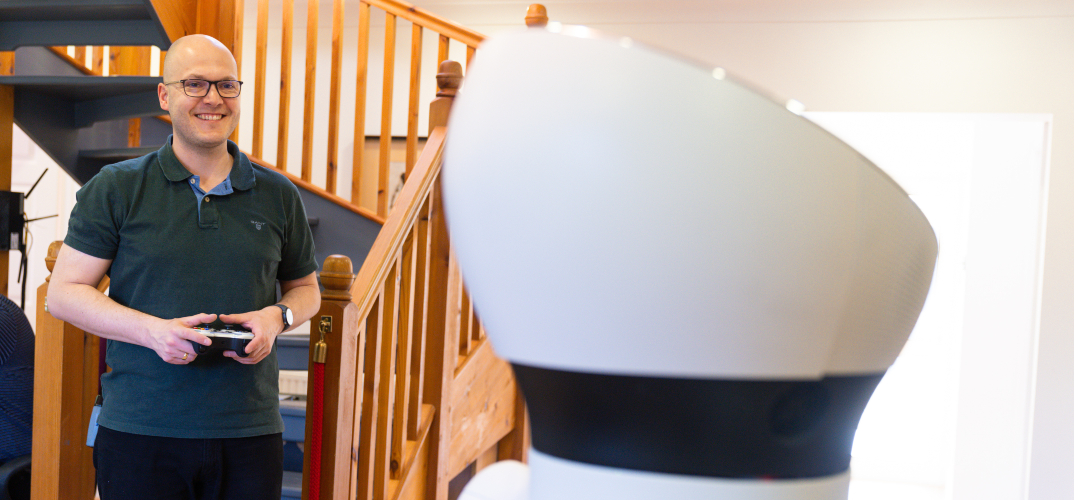Meet the manager of Robot House: "I strive to understand how we can communicate with robot companions"

The potential for robotics to transform our lives is ever-increasing – with mini robots delivering groceries around Milton Keynes and Cambridge, humanoid robots joining the Amazon warehouse workforce, and new government funding recently announced for robotics to improve farming.
Dr Patrick Holthaus is a Senior Research Fellow in the Robotics Research Group within our School of Engineering, Physics and Computer Science. His research revolves around social robotics – how we will interact with, and possibly live alongside, robots in the future. As manager of the University’s Robot House, our unique research facility that tests robots in a home environment, Patrick brings together fundamental robotics research and real-world application, to understand how assistive and companion robots could become part of our everyday lives.
We spoke to Patrick to understand the future of human-robot interaction, how the public respond to his research – and how close we really are to having our own robot companions.
What is your research focused on, and why does it excite you?
My research revolves around the idea of making robots of any kind accessible to humans. I strive to understand how we can communicate with social beings that are not humans, but robot companions. Whilst our knowledge of communication between humans can often serve as a blueprint for designing robot behaviours, we still need to understand how to adapt these patterns to account for the differences between humans and robots. So, by far the most exciting aspect of my research is its requirement to involve many different research disciplines, so that we can create robots that are both useful and acceptable to us.
The integration of AI and robotics into day-to-day life seems inevitable. What do you think will be the biggest development in robotics in the coming years?
Assistive robots will be a huge area of growth because of the strong demand for automation and technology solutions in the health and care sectors, which are under severe pressure due to years of inadequate planning and chronic under-resourcing. As a consequence, I personally believe that assistive robots will become much more ubiquitous in people’s daily lives. In my research area, one of the most important developments is early patient- and user-involvement, so that any new solutions better suit people’s needs. This will heavily accelerate the way that people adopt smaller devices to improve individual aspects of their daily life – which will then pave the way for more comprehensive, multi-purpose assistive robots.
What impact do you want your research to have?
I’m aiming to change the way that interactive robotics is approached by putting the human user at the centre of attention from the very beginning. I consider the human perspective when drafting and evaluating robot appearances and behaviours, to fulfil their intended functionalities. For example, if we’re trying to design and programme a robot that provides companionship or assistance in the home, we need to know what characteristics a person looks for in a trusted companion, and what behaviours will be most helpful and most engaging, in order for people to accept a robot into their home.
You’ve recently showcased your research with assistive robots to the public through Robot Lab Live – tell us what these live-streamed showcases are like.
For the second year in a row, Robot Lab Live gave us the chance to stream a live demo of our assistive robots to anywhere in the world! It’s always exciting when the day of the live event arrives and the interaction with the audience begins. The feeling of excitement is very similar to a performance on stage where all the members of the team are giving their best. On top of that, in live robot demonstrations, all the robots must function smoothly to provide people with a great experience. Seeing everything we prepared so meticulously come together for a live demonstration is a very satisfying and exciting experience.
How do people react to seeing the robots in action?
The live performance includes a Q&A, which offers a wonderful opportunity for immediate feedback and exchange of ideas with potential future users of the technology that we’re showcasing. This year we had many great questions from the audience – the pure breadth of questions is a sign that people at home are really engaged with the different research areas that makes interaction with assistive robots possible.
Our decision to involve the viewers in the demonstration was definitely a highlight. Using an interactive poll, the audience was able to decide what the robots engaged in, without telling the research team. The audience loved being in control of the robots and the team!
How close are we really to seeing robots become part of our everyday life?
If you look around, you’ll already see many robots that are part of our everyday life! We have robot vacuum cleaners, service robots in shops, therapeutic devices, and robotic toys. However, these robots are typically specialised to help with a single, very defined task – which makes sense from a manufacturing and marketing perspective, as reliability is essential to any brand.
More advanced devices like autonomous vehicles or delivery drones are currently being tested and are slowly entering our lives, but they need to adhere to high safety standards in complex and ever-changing environments. That’s tremendously difficult and will take some more time. If you imagine how complex your home environment is – with pets, movable furniture, stuck drawers and stairs – it is difficult to think how a useful human-like robot, that can help with your household chores, will be available very soon. My assumption is that we’ll first get better appliances with added functionalities, and smaller robots that can help with a few more tasks, before we get socially assistive robots that communicate with us in a meaningful way.
To find out more about human-robot interaction research at Herts, and to meet our in-house robots, visit the Robot House website.